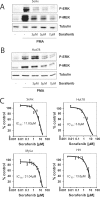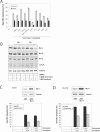NRAS mutations in cutaneous T cell lymphoma (CTCL) sensitize tumors towards treatment with the multikinase inhibitor Sorafenib
- PMID: 28537899
- PMCID: PMC5542218
- DOI: 10.18632/oncotarget.17669
NRAS mutations in cutaneous T cell lymphoma (CTCL) sensitize tumors towards treatment with the multikinase inhibitor Sorafenib
Abstract
Therapy of cutaneous T cell lymphoma (CTCL) is complicated by a distinct resistance of the malignant T cells towards apoptosis that can be caused by NRAS mutations in late-stage patients. These mutations correlate with decreased overall survival, but sensitize the respective CTCL cells towards MEK-inhibition-induced apoptosis which represents a promising novel therapeutic target in CTCL. Here, we show that the multi-kinase inhibitor Sorafenib induces apoptosis in NRAS-mutated CTCL cells. CTCL cell lines and to a minor extent primary T cells from Sézary patients without NRAS mutations are also affected by Sorafenib-induced apoptosis suggesting a sensitizing role of NRAS mutations for Sorafenib-induced apoptosis. When combining Sorafenib with the established CTCL medication Vorinostat we detected an increase in cell death sensitivity in CTCL cells. The combination treatment acted synergistically in apoptosis induction in both non-mutant and mutant CTCL cells. Mechanistically, this synergistic apoptosis induction by Sorafenib and Vorinostat is based on the downregulation of the anti-apoptotic protein Mcl-1, but not of other Bcl-2 family members. Taken together, these findings suggest that Sorafenib in combination with Vorinostat represents a novel therapeutic approach for the treatment of CTCL patients.
Keywords: RAS mutation; T cell lymphoma; kinase; small molecule inhibitor; targeted therapy.
Conflict of interest statement
J.P.N. received travel and congress participation funding by TEVA as well as consulting fees by TEVA and Biogen. C.D.K. received travel support for scientific conferences and lecture fees for scientific presentations from TEVA/Cephalon Pharma GmbH and Therakos, Johnson & Johnson Medical GmbH. He was a member of the TEVA Cutaneous Lymphoma Advisory Board. P.H.K. and K.G. received consulting fees by the Biogen. The project was supported by the DKFZ / Bayer HealthCare Alliance.
Figures




Similar articles
-
Sorafenib Sensitizes Glioma Cells to the BH3 Mimetic ABT-737 by Targeting MCL1 in a STAT3-Dependent Manner.Neoplasia. 2015 Jul;17(7):564-73. doi: 10.1016/j.neo.2015.07.003. Neoplasia. 2015. PMID: 26297434 Free PMC article.
-
Synergistic interactions between vorinostat and sorafenib in chronic myelogenous leukemia cells involve Mcl-1 and p21CIP1 down-regulation.Clin Cancer Res. 2007 Jul 15;13(14):4280-90. doi: 10.1158/1078-0432.CCR-07-0835. Clin Cancer Res. 2007. Retraction in: Clin Cancer Res. 2016 Oct 1;22(19):4959. doi: 10.1158/1078-0432.CCR-16-1914. PMID: 17634558 Retracted.
-
High-throughput mutation profiling of CTCL samples reveals KRAS and NRAS mutations sensitizing tumors toward inhibition of the RAS/RAF/MEK signaling cascade.Blood. 2011 Feb 24;117(8):2433-40. doi: 10.1182/blood-2010-09-305128. Epub 2011 Jan 5. Blood. 2011. PMID: 21209378 Free PMC article.
-
Targeted treatment of ovarian cancer--the multiple - kinase - inhibitor sorafenib as a potential option.Anticancer Res. 2014 Apr;34(4):1519-30. Anticancer Res. 2014. PMID: 24692678 Review.
-
State of the art of the therapeutic perspective of sorafenib against hematological malignancies.Curr Med Chem. 2012;19(28):4875-84. doi: 10.2174/092986712803341548. Curr Med Chem. 2012. PMID: 22934770 Review.
Cited by
-
Dimethyl fumarate and extracorporeal photopheresis combination-therapy synergize in inducing specific cell death and long-term remission in cutaneous T cell lymphoma.Leukemia. 2025 Feb;39(2):438-450. doi: 10.1038/s41375-024-02479-1. Epub 2024 Nov 23. Leukemia. 2025. PMID: 39580583 Free PMC article.
-
Point Mutation Specific Antibodies in B-Cell and T-Cell Lymphomas and Leukemias: Targeting IDH2, KRAS, BRAF and Other Biomarkers RHOA, IRF8, MYD88, ID3, NRAS, SF3B1 and EZH2.Diagnostics (Basel). 2021 Mar 27;11(4):600. doi: 10.3390/diagnostics11040600. Diagnostics (Basel). 2021. PMID: 33801781 Free PMC article. Review.
-
[Treatment of mycosis fungoides and Sézary syndrome].Hautarzt. 2017 Sep;68(9):702-710. doi: 10.1007/s00105-017-4021-5. Hautarzt. 2017. PMID: 28770285 Review. German.
-
Targeting PTGDS Promotes ferroptosis in peripheral T cell lymphoma through regulating HMOX1-mediated iron metabolism.Br J Cancer. 2025 Mar;132(4):384-400. doi: 10.1038/s41416-024-02919-w. Epub 2024 Dec 20. Br J Cancer. 2025. PMID: 39706989 Free PMC article.
References
-
- Jawed SI, Myskowski PL, Horwitz S, Moskowitz A, Querfeld C. Primary cutaneous T-cell lymphoma (mycosis fungoides and Sezary syndrome): part II. Prognosis, management, and future directions. J Am Acad Dermatol. 2014;70:223 e221–217. quiz 240–222. - PubMed
-
- Whittaker S, Hoppe R, Prince HM. How I treat mycosis fungoides and Sezary syndrome. Blood. 2016;127:3142–3153. - PubMed
MeSH terms
Substances
LinkOut - more resources
Full Text Sources
Other Literature Sources
Miscellaneous

